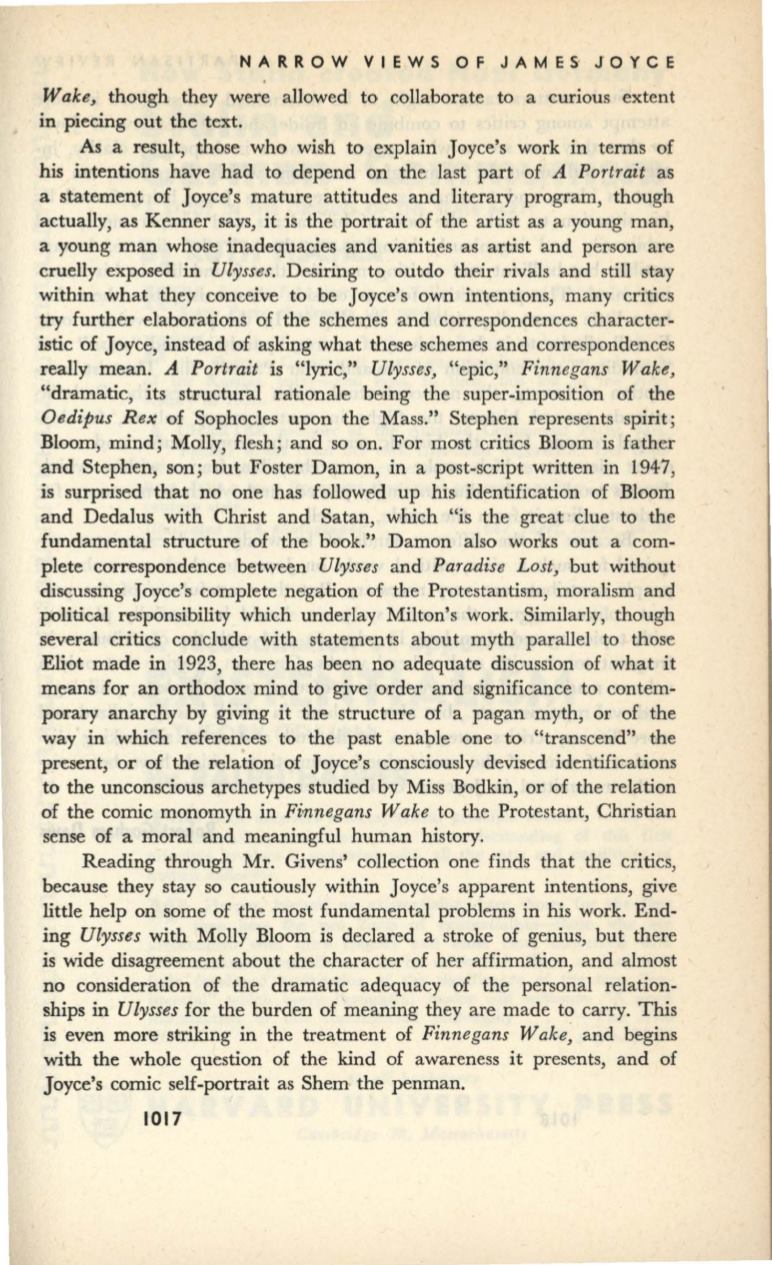
NARROW
VIEWS OF JAMES· JOYCE
Wake,
though they were allowed to collaborate to a
curious
extent
in piecing out the text.
As a result, those who wish to explain Joyce's work in terms of
his intentions have had to depend on the last part of
A
Portrait
as
a statement of Joyce's mature attitudes and literary program, though
actually, as Kenner says, it is the portrait of the artist as a young man,
a young man whose inadequacies and vanities as artist and person are
cruelly exposed in
Ulysses.
Desiring to outdo their rivals and still stay
within what they conceive to be Joyce's own intentions, many critics
try further elaborations of the schemes and correspondences character–
istic of Joyce, instead of asking what these schemes and correspondences
really mean.
A
Portrait
is "lyric,"
Ulysses,
"epic,"
Finnegans Wake,
"dramatic, its structural rationale being the super-imposition of the
Oedipus Rex
of Sophocles upon the Mass." Stephen represents spirit;
Bloom, mind; Molly, flesh; and so on. For most critics Bloom is father
and Stephen, son; but Foster Damon, in a post-script written in 1947,
is surprised that no one has followed up his identification of Bloom
and Dedalus with Christ and Satan, which "is the great clue to the
fundamental structure of the book." Damon also works out a com–
plete correspondence between
Ulysses
and
Paradise Lost,
but without
discussing Joyce's complete negation of the Protestantism, moralism and
political responsibility which underlay Milton's work. Similarly, though
several critics conclude with statements about myth parallel to those
Eliot made in 1923, there has been no adequate discussion of what it
means for an orthodox mind to give order and significance to contem–
porary anarchy by giving it the structure of a pagan myth, or of the
way in which references to the past enable one to "transcend" the
present, or of the relation of Joyce's consciously devised identifications
to the unconscious archetypes studied by Miss Bodkin, or of the relation
of the comic monomyth in
Finnegans Wake
to the Protestant, Christian
sense of a moral and meaningful human history.
Reading through Mr. Givens' collection one finds that the critics,
because they stay so cautiously within Joyce's apparent intentions, give
little help on some of the most fundamental problems in his work. End–
ing
Ulysses
with Molly Bloom is declared a stroke of genius, but there
is wide disagreement about the character of her affirmation, and almost
no consideration of the dramatic adequacy of the personal relation–
ships in
Ulysses
for the burden of meaning they are made to carry. This
is even more striking in the treatment of
Finnegans Wake,
and begins
with the whole question of the kind of awareness it presents, and of
Joyce's comic self-portrait as Shem the penman.
1017


